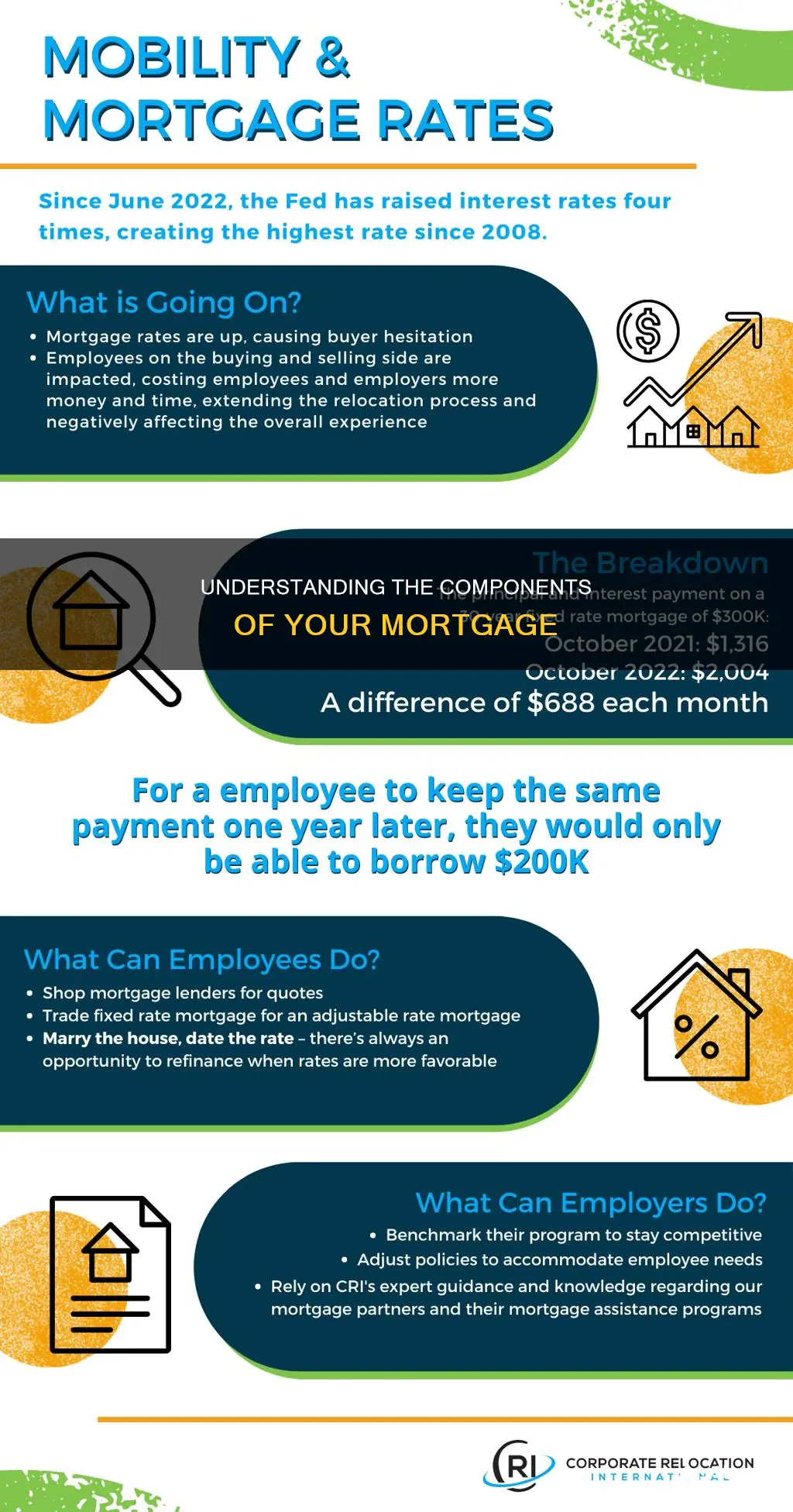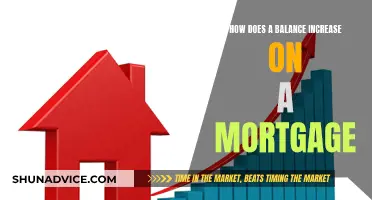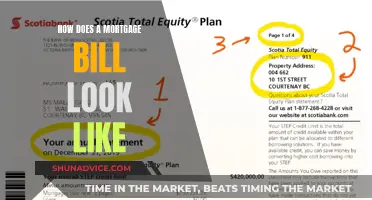
A mortgage is a loan from a lender that allows you to finance a home purchase. When you take out a mortgage, you are promising to repay the money you've borrowed at an agreed-upon interest rate. This interest rate is calculated as a percentage of the remaining loan balance. Your monthly mortgage payments are made up of your principal and interest payments. The principal is the amount you borrowed from your lender to purchase your home. In the beginning, you owe more interest as your loan balance is high, but over time, as you pay down the principal, you owe less interest each month. Your monthly mortgage payments also include property taxes and insurance.
What You'll Learn

Principal, interest, taxes, and insurance
The principal is the original amount of money borrowed from a lender to purchase a home. In the beginning, a smaller amount of each mortgage payment goes toward the principal, while a larger amount goes toward interest. Over time, as the loan matures, this shifts, and more of the payment goes toward the principal, with less going toward interest. Paying down the principal reduces the amount you owe on the loan and builds your equity.
Interest is the fee you pay to the lender for borrowing money. It is calculated as a percentage of the remaining loan balance. In the early part of the mortgage, a larger amount of each payment goes toward interest, while the latter part favors the principal balance. This is because you owe more interest at the beginning of the mortgage term, as your loan balance is still high. As you pay down the principal, you owe less interest each month because your loan balance is lower.
Property taxes are typically collected by the lender and held in an escrow account, then paid to the local government on the homeowner's behalf. These taxes are calculated based on the assessed value of the property and the tax rate in the area. As property taxes can fluctuate annually, a homeowner's mortgage payment may be adjusted to reflect changes in tax rates or assessed value.
Homeowners insurance protects the homeowner and the lender in case of damage to the property from events like fire, storms, or theft. Like property taxes, insurance payments are often held in escrow and paid by the lender. The amount can vary based on coverage levels and the home's location. Having this insurance is usually required to safeguard the home and the lender's investment.
Writing a Gift Letter for Your Mortgage: A Simple Guide
You may want to see also

Down payments
A down payment is the amount of money you pay upfront to buy a home. The amount you pay will influence the size of your mortgage payments. The larger the down payment, the lower your mortgage payments will be.
Most lenders ask for a 20% down payment. This is because, with a lower down payment, you are considered a riskier borrower. As a result, you will be required to take out private mortgage insurance (PMI) to protect the lender against losses if they have to foreclose on your home. PMI increases your monthly payments, so it is in your interest to make a 20% down payment if you can.
There are mortgage programs available that allow significantly lower down payments. For example, a Federal Housing Administration (FHA) loan allows lower down payments, but you will pay a Mortgage Insurance Premium (MIP) instead of PMI. MIP has an upfront cost at closing and an ongoing annual premium, typically for the life of the loan unless you refinance.
If you are midway through your existing mortgage term and want to change it, you will likely need to break your mortgage. This can be costly, often racking up thousands of dollars in penalties, depending on the type of mortgage and the number of years left on the term.
Shorting Mortgage Bonds: A Risky Bet on Interest Rates
You may want to see also

Mortgage insurance
If you have an FHA loan, you will pay a Mortgage Insurance Premium (MIP) instead of PMI. MIP has an upfront cost at closing and an ongoing annual premium, typically required for the life of the loan unless you refinance. MIP is specific to FHA loans and provides extra security for lenders, allowing more buyers to qualify with lower down payments. FHA mortgage insurance includes both an upfront cost, paid as part of your closing costs, and a monthly cost, included in your monthly payment. If you don’t have enough cash on hand to pay the upfront fee, you are allowed to roll the fee into your mortgage instead of paying it out of pocket. However, doing so increases both your loan amount and your overall costs.
If you have a Department of Veterans' Affairs (VA)-backed loan, the VA guarantee replaces mortgage insurance, and functions similarly. With VA-backed loans, there is no monthly mortgage insurance premium. However, you pay an upfront "funding fee" that varies based on several factors. Like FHA and USDA loans, you can roll the upfront fee into your mortgage, but this will increase both your loan amount and your overall costs. Once you’ve paid off some of your loan, you may be eligible to cancel your mortgage insurance, meaning you won't have to pay the monthly cost.
Removing Deceased Spouse from Mortgage: What You Need to Know
You may want to see also

Breaking a mortgage contract
Before breaking your mortgage contract, it is important to carefully consider the costs and benefits. Contact your lender to understand the specific fees and penalties associated with ending your contract early. These may include prepayment penalties, administrative fees, and other charges. Additionally, you may be required to undergo a mortgage stress test again and qualify at a higher rate than your contract rate.
There are a few options to consider when breaking your mortgage contract. One option is to renegotiate your contract with your current lender for a lower interest rate and more favourable terms. This is known as a "blend-and-extend" option, where your old interest rate is blended with the new term's interest rate, and your term is extended. Another option is to switch to a new lender, which may allow you to secure a lower interest rate and better terms. However, this option typically incurs prepayment penalty fees.
It is worth noting that if you have an open mortgage, you may be able to break the contract without paying a prepayment penalty. On the other hand, breaking a closed mortgage contract usually incurs a prepayment penalty, which can cost thousands of dollars. Additionally, you may have to repay any cashback you received when you obtained your mortgage.
Cosigning a Mortgage: Benefits and Risks for All Involved
You may want to see also

Fixed-rate and adjustable-rate mortgages
When it comes to mortgages, there are two main types: fixed-rate and adjustable-rate. Fixed-rate mortgages are the most common, and they have an interest rate that remains the same throughout the term of the mortgage. This means that your monthly payments will always be the same, which can make budgeting easier. The interest rate for a fixed-rate mortgage is set when you take out the loan, and it won't change for the duration of the loan. This can provide stability and predictability for borrowers, as they know exactly how much their monthly payments will be.
However, it's important to note that the proportion of the principal (the amount borrowed) and interest paid may change over time. In the beginning, most of the monthly payment goes towards interest, but as the loan matures and the principal is paid down, more of the payment goes towards the principal. This process is known as amortization. Additionally, if interest rates drop a few years into a fixed-rate mortgage, borrowers may be able to refinance their mortgage at a lower rate.
On the other hand, adjustable-rate mortgages (ARMs) have interest rates that can change over time based on broader market trends. The interest rate for an ARM is usually lower than that of a fixed-rate mortgage at the beginning of the loan. However, after an introductory period, the interest rate for an ARM will change at regular intervals, typically every six months, and the amount of the payment is likely to go up. These changes are tied to a broader measure of interest rates, called an index, and the interest rate will increase when this index of interest rates goes up.
ARMs can be more complicated than fixed-rate mortgages, and it's important to understand the terminology before choosing this option. The adjustment frequency refers to how often the interest rate is adjusted, and the adjustment index is the benchmark that the interest rate adjustments are tied to. Additionally, the margin is the percentage added to the index by the lender to set the interest rate. While ARMs can offer lower initial interest rates, there is a chance that the interest rate will reset higher, increasing the mortgage payment. However, ARMs typically have caps that limit how much the interest rate can change over the life of the loan.
Closing Costs: Rolling Them into Your Mortgage
You may want to see also
Frequently asked questions
A mortgage is a loan you get from a lender to finance a home purchase. The home is used as collateral.
The components of a mortgage payment are principal, interest, taxes, and insurance (PITI). The principal is the amount borrowed from the lender to purchase the home. Interest is the fee you pay to the lender for borrowing money. Taxes refer to property taxes, which are based on the assessed value of the property and the local tax rate. Insurance includes homeowners insurance, which protects against damage to the property, and private mortgage insurance (PMI), which is required if the down payment is less than 20%.
A down payment is the amount of money you pay upfront to buy a home. A larger down payment will reduce your monthly mortgage payments and increase the equity in your home. If your down payment is less than 20%, you will typically be required to take out PMI, which increases your monthly payments.
Breaking a mortgage contract means exiting the contract with the lender before the maturity date. This can occur due to various circumstances, such as selling the property, refinancing, or personal reasons. Breaking the contract typically incurs penalties, including prepayment penalties and other fees associated with setting up a new mortgage.







